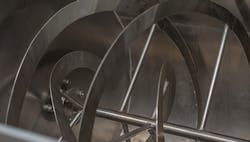The past 24 months have really tested the mettle of us, not only as individuals, but as companies and corporations. To say that this is a different work environment today than it was in November 2019 would be a very accurate statement.
As with any great struggle, these events bring out the best in some and the worst in others. A pandemic is certainly about the worst that life can throw at us and how we react to that challenge can define who we are and what the future will mean for us.
In the life of a co-packer, there are some patterns that help us to guide our yearly planning. For example, as a food producer, we can expect to have some peak activity from roughly the end of July through the end of the calendar year.
Our peak season can usually be attributed to the winding down of summer and the return to the kitchen. Great gatherings at Labor Day, Thanksgiving, Christmas and the New Year mean people are in the mind to make things at home, and that is where we make some of our bread and butter.
The coming of cooler months also means an increase in consumption of feel-good products such as soup and stuffing. Following this crazed rate of production, we can normally expect a slowdown in which we catch our breath, and it is during this welcome respite that we like to plan some equipment upgrades.
Well, the current buzz of activity around the pandemic and the economic response to the challenges presented by the virus have created an environment where our usual slowdown didn’t come. In fact, we haven’t really had a slowdown in close to three years.
Like many manufacturers, we continue to face the two-headed monster in the guise of an increased demand for our products and a reduced labor force. While we did see a slight increase in labor interest after the federal unemployment funding expired, it hasn’t really taken hold in the form of feet on the floor.
Our management group has to evaluate our production expectations on a daily basis and decide how we can prioritize staffing to meet critical needs while extending our normal work hours to make up for the lack of labor. All of this has put some pressure on our usual planning for equipment upgrades. We still have the same needs but lack the downtime and resources, that is, people, to execute the tasks.
An interesting trend has formed out of this challenge. Like any manufacturing facility, there tends to be a strung-out list of lifecycle, based on how long we have owned the equipment and what has survived the test of time.
Plans to upgrade can quickly get messed up if you can’t execute the job in a timely manner, and such was the case for us recently. We rely heavily on 12 ribbon blenders to mix our component products. With the exception of one that was added in 2016, these systems were all installed in the early 2000s and, credit to the designers, are still with us today.
As with any system that runs well, we tend not to dwell too much on the longevity of the control system. This is real life and, like any other company, we find ourselves replacing components from time to time, but, in general, these have been very reliable machines in our inventory.
A failure happened, while I was on vacation, of course, and we were stunned to learn that the vendor no longer sold that particular product line. It had been phased out a few years ago, and our well-performing machines had quietly watched as the availability of replacement components disappeared in the rearview mirror. No fanfare, no alarms going off—just quietly extinct.
Now you might be thinking to yourself, how could I have let this all happen? Didn’t I have a plan to replace these aging systems with modern versions? Well, yes, I did have a plan. In fact, we set out to buy an upgrade every year or so and cycle through the inventory until we ran out of old stuff.
I’m sure you can figure out where this is going, but busy production schedules, focus on buying new equipment and a pandemic that suddenly loomed large in the windscreen left us with kits sitting on the shelves waiting for “someday” to turn them into reality. So, someday became today, and, lo and behold, we crack open the first kit only to discover that we had used some of the replacement components to do emergency repairs a couple of years ago and somehow forgot to buy parts to replenish the kit.
The solution was simple, so it seemed. Call the vendor and buy the missing components. But out of the distance comes the next dark cloud, and the upgrade components have also become obsolete. Worse yet, there isn’t a newer version from that particular vendor. They seem to be out of the business of this particular product line.
To add one more kick to the gut, my original planning included going through about 95% of the conversion of the old PLC to new PLC, old HMI platform to a new one from a different manufacturer, and now I was faced with completely building a new HMI application from scratch because, yet again, we were going to have to switch manufacturers.
I share these life experiences with you because I would like to think that, while we wouldn’t want these sorts of things to ever happen, the truth is they do; and they happen to good people and bad people alike.
Despite the best laid plans, these things can and will happen. Some of you at this point are probably imagining what it would feel like if you were the subject of this experience and, probably shortly thereafter, are asking yourself, “What would I do if this happened to me?”
Well, after catching my breath and reminding myself that this has happened before and I’m still alive, I set about deciding on a quick path forward. I’ve got a ribbon blender down, and it needs to get back into production. The chosen upgrade PLC is still good, thankfully, so the real challenge is the HMI.
As many of you know, upgrades are a big part of what I do for my employer. Within the past year, we have modernized both a horizontal cartoner and a horizontal packager that started life in the 1970s. These control systems have all the latest technology in them, including the same PLC platform that our new mixer upgrade has. They even share a common HMI platform, and this is where the solution to my challenge lies.
Hours of development went into, first, the cartoner application and, second, the packager application. As a result, I have a library of screen templates from these successful projects. A mixer might be a totally different piece of equipment than a cartoner or a pouch maker, but, at the HMI level, it is still just buttons, selectors and numeric entry/display points.
All of this discovery and resolution came together extremely quickly. We decided to bring in an outside contractor to do the physical swap out of the PLC and mount new boxes and HMI terminals. In the three days that it took for that work to be completed, I managed to pull the various aspects of an HMI application out of my already completed projects and had applications ready to download into the terminals when the contractor was ready to power up the panels. Two days later, the recommissioned mixer was put back into production.
For me, there was a hard lesson in all of this. Looking forward is definitely a primary function of a controls engineer, and keeping up on the latest technology is key to success. Unfortunately, circumstances like ours delayed upgrade plans added a degree of stress to the situation, but it was our insistence on pushing the technology forward, instead of getting complacent with maintaining the existing base, that ended up saving the day for us.
Entirely due to this experience, we are already planning to implement the next mixer upgrade—since the kit is already here—with our contractor back in to do the job for us again.
Sometimes we can hold off on things that need to get done for very legitimate reasons. We get busy, other things rise to the top of list of priorities, a pandemic rears its ugly head—the list goes on and on.
It’s easy to lose sight of the target, and, as we found out here, if enough gap happens between planning and execution, the march forward with technology can march right past the plan. Then we are caught flat-footed when the crisis strikes.
Our approach to automation here at my place of employment has readily adapted itself to a machine-of-any-flavor solution, and it definitely saved us, yet again.
Rick Rice is a controls engineer at Crest Foods, a dry-foods manufacturing and packaging company in Ashton, Illinois. With more than 30 years’ experience in the field of automation, Rice has designed and programmed everything from automotive assembly, robots, palletizing and depalletizing equipment, conveyors and forming machines for the plastics industry but most of his career has focused on OEM in the packaging machinery industry with a focus on R&D for custom applications. Contact him at [email protected].
About the Author
Rick Rice
Contributing Editor
Rick Rice is a controls engineer at Trew Automation, a material handling manufacturer based in West Chester, Ohio. With over 38 years’ experience in the field of automation, Rice has designed and programmed everything from automotive assembly, robots, palletizing and depalletizing equipment, conveyors and forming machines for the plastics industry but most of his career has focused on OEM in the packaging machinery industry with a focus on R&D for custom applications.

Leaders relevant to this article:


